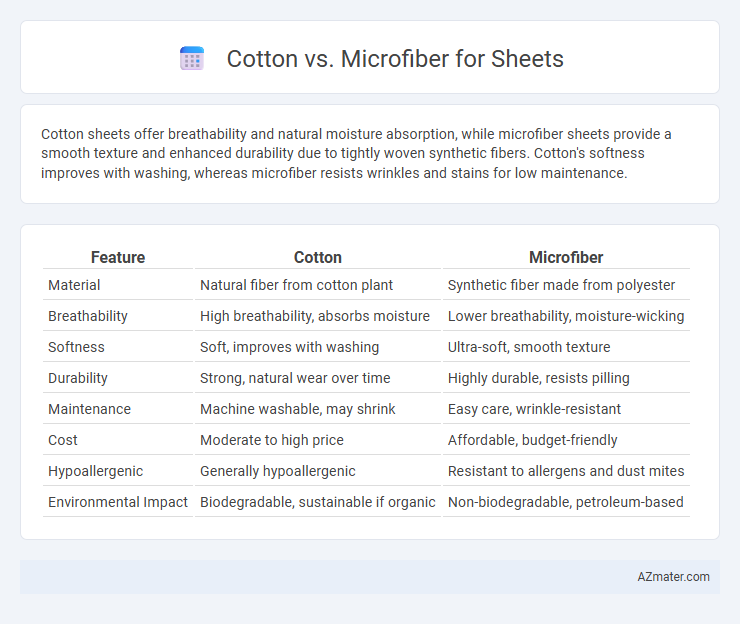Cotton sheets offer breathability and natural moisture absorption, while microfiber sheets provide a smooth texture and enhanced durability due to tightly woven synthetic fibers. Cotton's softness improves with washing, whereas microfiber resists wrinkles and stains for low maintenance.
Table of Comparison
| Feature | Cotton | Microfiber |
|---|---|---|
| Material | Natural fiber from cotton plant | Synthetic fiber made from polyester |
| Breathability | High breathability, absorbs moisture | Lower breathability, moisture-wicking |
| Softness | Soft, improves with washing | Ultra-soft, smooth texture |
| Durability | Strong, natural wear over time | Highly durable, resists pilling |
| Maintenance | Machine washable, may shrink | Easy care, wrinkle-resistant |
| Cost | Moderate to high price | Affordable, budget-friendly |
| Hypoallergenic | Generally hypoallergenic | Resistant to allergens and dust mites |
| Environmental Impact | Biodegradable, sustainable if organic | Non-biodegradable, petroleum-based |
Introduction to Cotton and Microfiber Sheets
Cotton sheets, made from natural fibers, offer breathability, moisture-wicking, and softness, making them ideal for warm climates and sensitive skin. Microfiber sheets, crafted from finely woven synthetic fibers such as polyester, provide durability, wrinkle resistance, and affordability with a smooth texture. Both materials cater to different needs, with cotton excelling in natural comfort and microfiber in easy maintenance and cost-effectiveness.
Material Composition: Cotton vs Microfiber
Cotton sheets are made from natural fibers harvested from the cotton plant, known for their breathability, softness, and moisture-wicking properties. Microfiber sheets consist of tightly woven synthetic fibers, typically polyester, offering enhanced durability, wrinkle resistance, and a smoother texture. The material composition directly influences airflow and comfort, with cotton providing better temperature regulation while microfiber excels in stain resistance and ease of maintenance.
Softness and Texture Comparison
Cotton sheets offer a natural softness that becomes more supple with each wash, providing a breathable texture ideal for sensitive skin. Microfiber sheets, made from finely woven synthetic fibers, deliver a consistently smooth and silky feel with a slight sheen, but can retain heat more than cotton. The choice between cotton and microfiber often hinges on personal preference for texture warmth and maintenance, with cotton favored for its natural breathability and microfiber prized for its wrinkle resistance.
Breathability and Temperature Regulation
Cotton sheets excel in breathability due to their natural fibers, allowing air to circulate freely and helping to regulate body temperature effectively during sleep. Microfiber sheets, made from tightly woven synthetic fibers, offer less breathability and tend to trap heat, making them warmer but less ideal for hot sleepers. For optimal temperature regulation and moisture-wicking properties, cotton sheets are generally preferred, especially in warmer climates or for those prone to night sweats.
Durability and Longevity
Cotton sheets, especially those made from long-staple fibers like Egyptian or Pima cotton, offer exceptional durability and become softer with each wash, lasting up to a decade with proper care. Microfiber sheets, crafted from finely woven synthetic fibers such as polyester, provide high resistance to wear, shrinking, and wrinkles, maintaining their integrity for around five to seven years. While cotton excels in breathability and natural fiber strength, microfiber stands out for its quick-drying properties and consistent performance in durability over time.
Maintenance and Care Requirements
Cotton sheets require regular washing in cold or warm water and occasional ironing to maintain their softness and durability, with natural fibers prone to shrinking and wrinkling over time. Microfiber sheets offer low-maintenance care, drying quickly and resisting wrinkles, stains, and shrinking due to their synthetic polyester composition. Both materials benefit from avoiding high heat during laundering to extend their lifespan and preserve fabric integrity.
Allergy and Skin Sensitivity Considerations
Cotton sheets are naturally hypoallergenic and breathable, making them ideal for individuals with allergy or sensitive skin concerns, as they reduce irritation and allow better airflow to prevent sweat buildup. Microfiber sheets, made from finely woven synthetic fibers, resist allergens like dust mites due to their tight weave but may trap heat and moisture, potentially aggravating sensitive skin conditions. Choosing cotton is generally recommended for allergy sufferers seeking natural comfort, while microfiber offers durability and allergen resistance but requires careful consideration of skin sensitivity.
Eco-Friendliness and Sustainability
Cotton sheets, especially organic cotton, are biodegradable and renewable, making them a more eco-friendly choice compared to synthetic microfiber sheets, which are derived from petroleum-based materials and contribute to microplastic pollution. The production of organic cotton uses less water and fewer harmful pesticides, reducing environmental impact, whereas microfiber manufacturing involves non-renewable resources and releases microfibers that contaminate waterways. Recyclability and compostability of cotton enhance its sustainability profile, while microfiber sheets often persist in landfills and ecosystems, posing long-term ecological risks.
Price and Value for Money
Cotton sheets generally come at a higher price point than microfiber due to natural fiber costs and breathability, offering long-term durability and comfort that can justify the initial investment. Microfiber sheets are more affordable upfront, providing soft texture and wrinkle resistance, but may wear out faster and trap heat. Evaluating price against value for money depends on prioritizing natural feel and longevity with cotton or budget-conscious softness and easy care with microfiber.
Which Sheet is Right for You?
Cotton sheets offer breathability, natural softness, and durability, making them ideal for those who prefer a cooling, hypoallergenic fabric with a classic feel. Microfiber sheets, composed of finely woven synthetic fibers, provide wrinkle resistance, affordability, and a silky texture for individuals seeking low-maintenance bedding with enhanced moisture-wicking properties. Choosing the right sheet depends on your preferences for temperature regulation, fabric care, and budget considerations.

Infographic: Cotton vs Microfiber for Sheet
 azmater.com
azmater.com